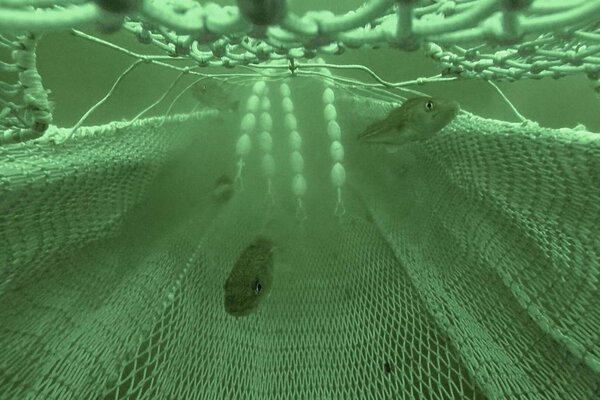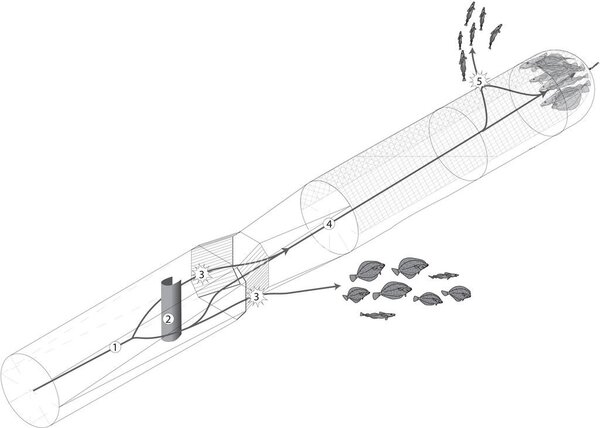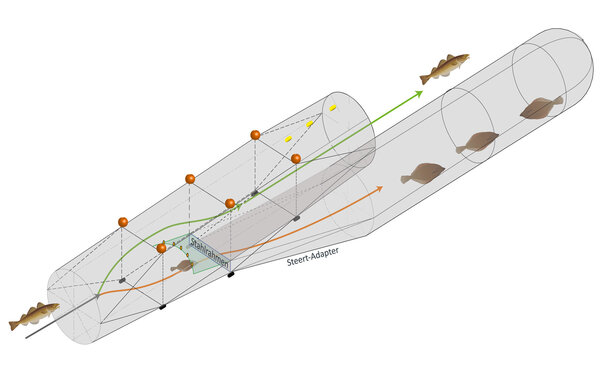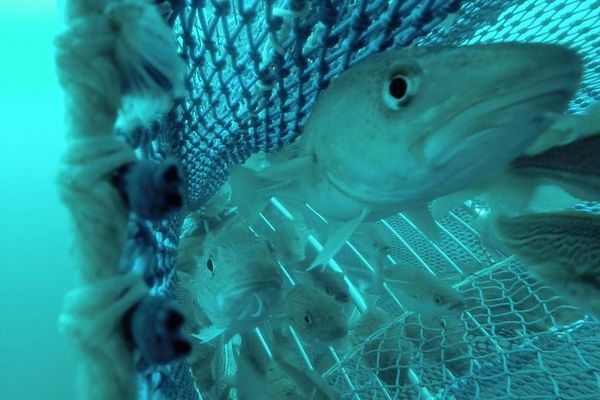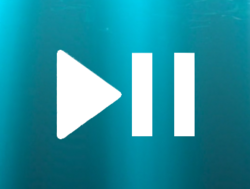Expertise
Reduction of unwanted bycatch of fish
Daniel Stepputtis
How can the selectivity of trawl nets be improved so that there is less bycatch? The fish themselves provide important clues to this with their behavior.
In principle, all trawl nets catch in the same way: They herd the fish fleeing from the approaching danger until they drop exhausted into the funnel-shaped net. Finally, the fish gather in the rearmost part of the net, the codend or net bag, and are caught. Small fish slip through the meshes when they are large enough. Mesh size and shape are often (but not always) adjusted to the desired size of the target species.
With conventional bottom trawls, such as those used to catch cod or flatfish in the Baltic Sea, it is almost impossible to keep other fish species out. Almost inevitably, they are caught along with them (so-called "mixed fishing"). However, according to EU regulations, bycatches of species with catch quotas must also be landed and counted against the quota. This increases the incentive to fish more selectively, i.e. to reduce unwanted bycatch.
Nets with "emergency exit"
Skillfully chosen modifications to the net make it possible to exploit the different body shapes and behavior of the species for selection: Cod, for example, generally flee upward, while flatfish, as bottom-dwellers, flee downward. If they are offered specific escape options – for example, larger meshes in the pre-net or species-specific escape grids – they divide up accordingly. How efficient such solutions are, however, depends crucially on whether the unwanted fish and other creatures actually use these escape options.
The following are some development examples of nets with "emergency exit":
We observed fish underwater, studied their behavior in the net and the properties of the net when fishing. We used this experience to improve net selection. The result was "Freswind," a net for cod fishing designed to reduce flatfish bycatch.
The operating principle: fish arriving in the net bag are made to swim to the side by a vertical obstacle. There, escape grids made of parallel bars are installed, through which flatfish and small cod can escape. Large cod and very thick flatfish are guided through to the rear. The Freswind has succeeded in reducing flatfish catches by over 60%. The catch of small, undersized cod was also reduced by 25%. The net received the WWF's "Smart Gear" award in 2015. Our video, which received a lot of media attention, shows development steps.
A further development of the Freswind net is the Flatfish Excluder. A bottom-mounted "emergency exit" at the beginning of the net bag allows flatfish, which intuitively swim downward in case of danger, to escape while cod are caught. The new type of net is easier to handle in practice than its predecessor. This principle can also be used to specifically catch flatfish and allow cod to escape: For this purpose, the "emergency exit" only has to be placed upwards.
Selective fishing does not only mean reducing the bycatch of unwanted fish species. Undersized fish, i.e. fish that are too small to be landed yet, should also be able to escape from the nets. This is relatively easy to do by choosing appropriate mesh sizes and arrangements. However, from a population biology perspective, it may also be wise to ensure the survival of old, large fish, as they are of particular value to the reproduction of the stock. For example, a 10-year-old female cod will lay up to 40 times as many eggs as a young one that has just reached sexual maturity.
Fisheries scientists at the Thünen Institute have developed a net that provides an escape route for both small and large cod, so that it is primarily the medium size classes that are caught. In front of the net bag, they have installed a grid of sloping, parallel rods that guide fish to an escape window. If fish are so large that they do not fit through the grid, they are virtually forced to leave the net again through the window at the top. The others continue to swim to the end of the net. There, undersized fish still have the opportunity to escape through special escape windows consisting of larger meshes.

